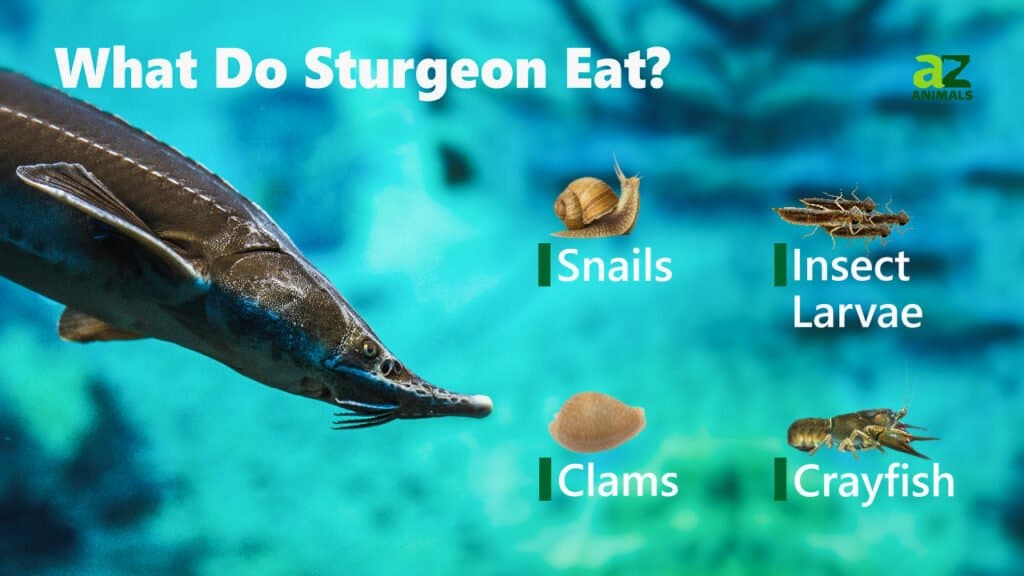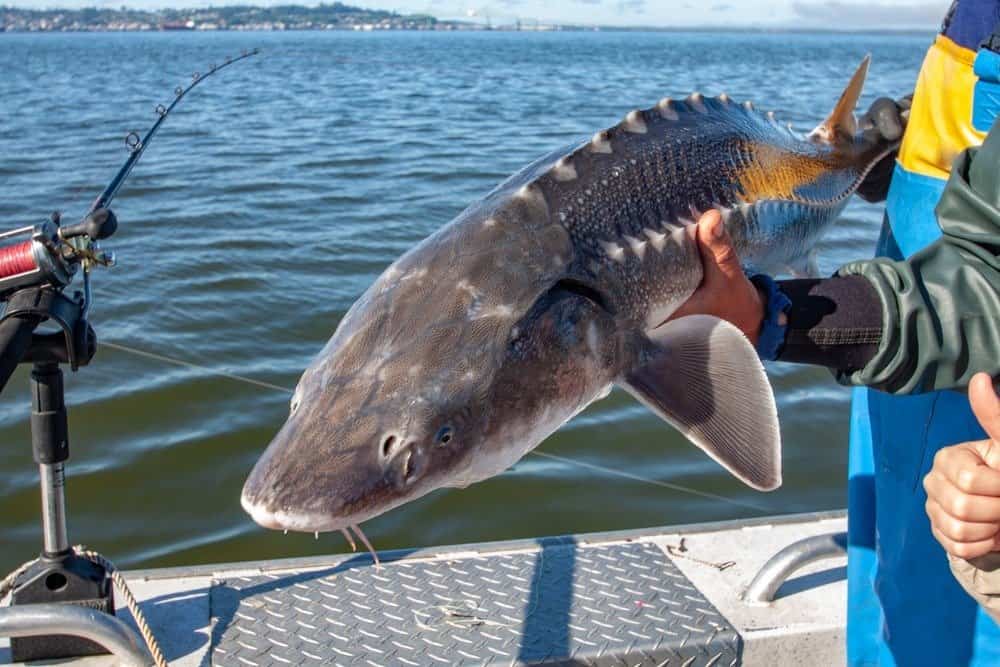Sturgeon are ancient fish that have been around for 201 million years, giving them the title of “modern fossils” quite easily. They usually live in freshwater, but some species feed in brackish environments while others migrate up coastlines in seawater. There are 27 known species of sturgeon, all with their own unique habitats and behaviors. Let’s look at these amazing fish and learn: what do sturgeon eat?
What do sturgeon eat?

Sturgeon are benthic feeders that suck up shellfish, small fish, and gastropods from the bottom of their environment.
©/Shutterstock.com
Sturgeon eat shellfish, crustaceans, small fish, insects, and gastropods.
There are 27 species of sturgeon, all with different diets. Still, there are general similarities between all of them. Sturgeon are benthic feeders, meaning they feed on the bottom layer of a water ecosystem. This equates to sea floors, river beds, and lake beds.
Most species stick to smaller prey, particularly when they are smaller themselves. These benthic feeders often feed on the filter feeders that live near the bottom of an ecosystem, providing an important link from filter to predator. They generally act as a vacuum and sweep the muddy beds of watery ecosystems, looking for any food they prefer.
A complete list of the foods sturgeon eat
Here is a complete list of foods that surgeons eat:
- crayfish
- shrimp
- snails
- plants
- insects
- larvae
- worms
- slugs
- clams
- fish
- frogs
- lamprey
How do sturgeons get their food?

Sturgeon suck up their food with a vacuum-like mouth, swallowing it whole.
©Vladimir Wrangel/Shutterstock.com
Sturgeons don’t have teeth. Instead, these large fish sweep the bottoms of their environments, looking for their food. They then suck it up through their vacuum-like mouth, swallowing and digesting it whole. Their mouths are similar to suction tubes, and they will generally eat anything they can get into their mouths.
To aid in their search for food, sturgeon have an array of senses that allow them to find food in complete darkness. In fact, they don’t use visual sensory input at all in their search for food. Instead, they can taste, feel, and chemically sense nearby prey using their barbels situated at the front of their heads. A barbel is similar to whiskers on a cat, but for fish. Catfish also have barbels.
Additionally, sturgeons have electroreceptors in their heads. These sensors allow them to feel electrical signals from prey so they can then hone in on them with accuracy. Since animals put off a weak electric field (yes, even humans), the sturgeon can find small prey at the dark, muddy bottoms of rivers and lakes.
Sturgeon also love to leap out of the water and has become famous for their behavior. While there are multiple theories (and multiple reasons) that surgeons do this, one of the obvious ones is to catch insects in the air or on the surface of the water. Occasionally, the jumping act will land large surgeons into unsuspecting human boats!
What do different species of sturgeon eat?
There are 27 different species of sturgeon, with nine living in the United States. Most of the North American species are found in freshwater, with some occasionally migrating through saltwater.
White sturgeon are the largest and stronger inland fish of North America, growing up to 20 feet long and living more than 100 years old. White sturgeon live in rivers and estuaries near the ocean but migrate inland to spawn. White sturgeon eat fish eggs, shrimp, clams, and most interestingly, other fish. White sturgeon get so large that they incorporate large fish into their diets. Salmon, flounder, and herring are all prey for these massive animals.
Lake sturgeon live in freshwater environments across North America and eat leeches, clams, crayfish, and small fish. They seem to have a preference for worms, slugs, and snails. There is a rare species of sturgeon that solely lives in Alabama. It only lives within a 130 mile stretch of the Alabama River. These small sturgeon (only growing up to 2-3 feet) eat invertebrates and other small fish.
Bay dwelling sturgeon, the Atlantic, and shortnose sturgeon, live in the Chesapeake Bay. They generally eat shrimp, crustaceans, insects, mollusks, and worms. The fish migrate inward towards freshwater when they breed and lay eggs, where their diet changes accordingly.
People do keep sturgeon as pets. The most common species to be kept as pets are sterlet, diamond, and Siberian sturgeon. They normally live in ponds and private establishments but have special diets as a result. Generally, pet sturgeon are fed a diet that is 40% protein, with additional vitamins and minerals to keep them healthy.
What is good sturgeon bait?

Sturgeon prefer live bait and will follow the smell of a fish or shrimp oil.
©CSNafzger/Shutterstock.com
Sturgeon are some of the most prized sport fish in the world. Their size and immense strength contribute to them being one of the hardest fish to land. Still, many fishermen catch them, whether intentional or not.
When it comes to freshwater sturgeon, common baits include nightcrawlers and baitfish, often used in combination. Some sturgeon seem to have a preference for soft-bodied prey, making worms, slugs, and lampreys particularly effective. In addition to bait, many fishermen often scent the water with salmon eggs, shrimp oil, or sardine oil to attract hungry fish.
When fishing for saltwater sturgeon (like the white sturgeon and green sturgeon), many fishermen prefer fresh bait as they can smell it from far away. Shad, shrimp, and eel are typical baits used, and herring, anchovies, and squid sometimes get bites. Depending on where you are (in a river delta or on a shore), clams and shrimp are more likely to hit.
What predators do sturgeon have?
Sturgeons are some of the largest fish around, but they do have predators, especially when they are small. Once they are full-grown, their only real threat is humans. Additionally, they are covered in a bony plating that helps protect them from any sharp-toothed attackers.
Humans catch, breed, and harvest beluga sturgeon for their caviar. It is known as one of the most expensive caviars in the world, and its endangered nature has only increased the price.
The photo featured at the top of this post is © Максим Яковлєв / CC BY-SA 4.0 – License / Original
Thank you for reading! Have some feedback for us? Contact the AZ Animals editorial team.






